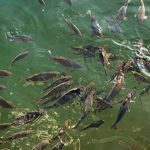What Happens to Fish When a Pond Freezes
When winter arrives, the temperature drops, and bodies of water freeze over, including ponds. This natural phenomenon has a significant impact on the aquatic life living in these ponds, particularly the fish. Have you ever wondered what happens to fish when a pond freezes? Let’s dive into the fascinating world of fish survival during the winter freeze.
### The Effects of Freezing Temperatures on Fish
As the temperature of the water drops, the water’s density changes, making it less dense. When water reaches 39.2°F (4°C), it becomes less dense, causing it to rise and the colder, denser water to sink. This process continues until the water reaches a uniform temperature throughout, which is around 39.2°F (4°C). This critical temperature is when the water is most dense, and any further drop in temperature causes the water to freeze.
### Adaptations of Fish to Cold Temperatures
Fish are incredibly adaptive creatures, and many species have evolved to survive in cold water. They possess various physiological and behavioral adaptations that enable them to withstand freezing temperatures. Some of these adaptations include the production of antifreeze proteins in their blood, which prevents the formation of ice crystals within their bodies. Additionally, fish can enter a state of hibernation, drastically reducing their metabolic rate to conserve energy during the winter months.
### Survival Strategies of Fish in Frozen Ponds
When a pond freezes, the fish are faced with a challenging and potentially life-threatening situation. As the water’s surface turns to ice, the fish must find ways to survive in this harsh environment. One common strategy employed by fish is to seek out areas of the pond where the water is deeper and less likely to freeze completely. These deeper areas provide a more stable temperature and a refuge from the icy conditions above.
### Oxygen Depletion and Its Impact
One of the most significant challenges that fish face in a frozen pond is the depletion of oxygen. As the surface of the pond freezes, it creates a barrier that prevents oxygen from entering the water. Additionally, the decomposition of organic matter, such as leaves and plant debris, consumes the limited oxygen available. This can lead to dangerously low oxygen levels, putting the fish at risk of suffocation.
### Survival Mechanisms of Fish in Low-Oxygen Environments
To survive in low-oxygen environments, fish have developed remarkable adaptations. Some species, such as carp and koi, are capable of breathing atmospheric oxygen through their gills, allowing them to access additional oxygen when levels in the water are low. Others, like the crucian carp, can switch to anaerobic respiration, a process that does not require oxygen but generates lactic acid as a byproduct. This adaptation allows these fish to survive in oxygen-deprived waters for extended periods.
### The Formation of Ice Cover and Its Impact on Fish
As the temperature continues to drop, a layer of ice forms on the surface of the pond, creating a physical barrier between the fish and the outside world. This ice cover reduces the amount of light penetrating the water, which can disrupt the natural rhythms of the fish and limit their access to food. Furthermore, the reduced light can impact the growth of aquatic plants, which serve as essential habitats and food sources for many fish species.
### Behavioral Changes in Fish during Winter
In response to the changing environmental conditions, fish exhibit various behavioral changes during the winter months. Many species become less active and reduce their movements to conserve energy. Some fish, such as certain types of trout, seek out areas of the pond where springs or groundwater sources provide a constant supply of relatively warmer water. These areas, known as thermal refuges, offer a reprieve from the frigid temperatures and help the fish survive the winter freeze.
### Human Interventions to Support Fish Survival
In some cases, humans may intervene to support the survival of fish in frozen ponds. One common method is to install aerators or bubblers in the pond to maintain a hole in the ice. This hole allows for the exchange of gases, preventing the buildup of toxic substances and ensuring a supply of oxygen for the fish. Additionally, feeding the fish with appropriate food in the winter can help sustain their energy levels and promote their survival until the ice thaws.
### The Thawing Process and Fish Resilience
As the winter season comes to an end and temperatures begin to rise, the ice covering the pond gradually thaws, signaling the arrival of spring. This thawing process is a critical time for the fish, as they emerge from their semi-dormant state and resume their normal activities. Despite the challenges they faced during the winter freeze, many fish species demonstrate remarkable resilience and adaptability, quickly rebounding as the pond returns to its liquid state.
In conclusion, the freezing of a pond has a profound impact on the fish inhabiting it, presenting a range of challenges that test their resilience and survival strategies. Through a combination of physiological adaptations and behavioral changes, fish have evolved to withstand the harsh conditions of winter and emerge victorious as the ice thaws. Understanding the effects of freezing temperatures on fish sheds light on the remarkable ways in which aquatic life copes with the changing seasons and inspires a deeper appreciation for the wonders of the natural world.



